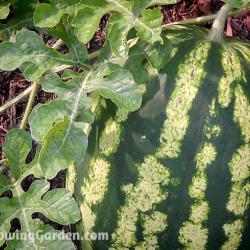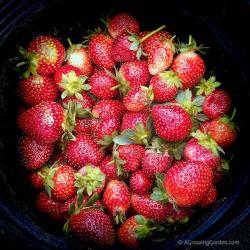
A few years ago when I decided I needed to buy a couple more fig trees, I ended up also buying 2 pomegranate trees. They were on sale and I couldn't resist. All I could think was, how fantastic would it be to be able to grow and eat pomegranates from my own yard? I don't know anyone who grows their own pomegranates! I'll be the talk of the town (LOL!).
Having never grown pomegranates before, or knowing anything about growing them for that matter, I was a little unsure about the purchase. But, after some quick research, I found that they are very similar in growing habit to figs, so I figured it was worth a try. Apparently, quite a lot of people grow pomegranates.... who knew?
I bought two pomegranate trees of the cultivar named "Wonderful." After all, with a name like "Wonderful", how could it go wrong?
When the plants arrived, I must admit I was a bit disappointed. As is often the case when ordering plants online or through a catalog and having them shipped to you, the plants were smaller than I imagined they would be. They were only about 12-15 inches tall and were planted in what seemed like the teeniest of tiny plastic pots.
I was sure it would take many, many years for them to get large enough to produce any fruit. But, I planted my little pomegranate trees anyway, gave them some water, and they've been growing like crazy ever since. After just 2 years, they've grown into shrubs that are easily 6 feet tall and about 3 or 4 feet wide. What's more, they are covered in flowers this year, and I am hopeful that we might actually get some fruit (fingers crossed!).
Here's what the pomegranate flower buds look like:

Pomegranate (Punica granatum)
Pomegranates are shrubs or small trees that get to be about 20 feet tall. They can be very, very long lived. Apparently there are pomegranate trees at Versailles that are over two centuries old ... can you believe that?
They have shiny, dark green foliage and produce really pretty red flowers. See?

Pomegranates are hardy in zones 7 through 10 and, like with so many other plants, seem to grow best in California. But, before packing up and heading to sunny California, you should give them a try in your own garden. They are easy to grow!
Preferring a soil pH of 5.5 to 7, pomegranates can tolerate a lot of different soil conditions. They like full sun and should be planted in the warmest spot of your yard or garden. After becoming well established, pomegranates can tolerate quite a bit of drought too.
It takes a few years for a young pomegranate tree to start setting fruit, so you might need to be patient. I'm hoping that this is the year that our little trees will start producing some fruit and I can start telling people that I grow my own pomegranates. I mean, how cool is that?













Join the Conversation!
February 20, 2016
Wonderful, woedfrnul, woedfrnul!!! I make a pomegranate salsa with parsley, cilantro, mint, red onion, lime salt and olive oil. I love it but always wear plastic gloves and old clothes to seed the pomegranates. Then know that I'll have another 20 minutes of kitchen clean-up in order to find all the spots of juice that fly out of the seeds. Thanks for your helpful tip!
Reply